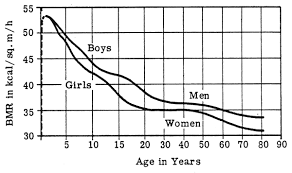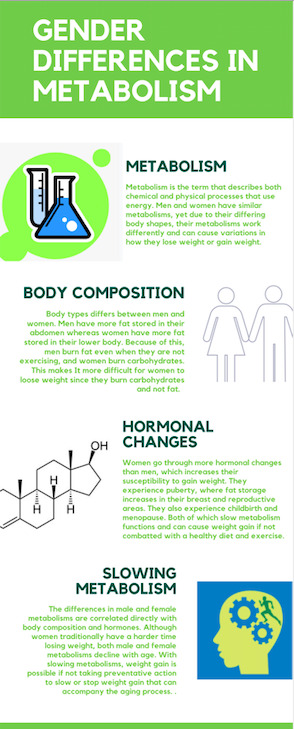6
Savannah Shope
What is Metabolism?
Metabolism is the term that describes both chemical and physical processes that use energy. This includes converting food to energy to fuel the human body. Males and females both have metabolisms that are similar in nature, yet the stereotypical bodies for males and females vary, which causes the differences in how effective their metabolisms function. There are many differences in the physiology, functions, and quality of metabolism based on gender. These variations contribute to differences in weight loss and caloric intake. However, the basic processes of metabolism remain the same in both males and females. Ninety percent of the energy used for every individual is due to muscle mass, fat mass, and activity level (Jefferson Regional Medical Center, 2018).
Differences in Fat Storage
When examining the differences in gender metabolism, fat storage plays a key role in explaining the variations. Males have more fat stored in their abdomen, whereas females have more fat between their muscles and skin and stored in their lower body. females have two thirds the skeletal mass and twice the adipose tissue as males (Lundsgaard & Kiens, 2014). Having a higher amount of abdominal fat puts males at a higher risk of heart disease, diabetes, and other predisposed health conditions. Therefore, the fat distribution in females is more beneficial. Females, however, have more slow-twitch muscle fibers, which means they use more fat while exercising. After exercising, females burn more carbohydrates, while males begin burning fat after exercising. This causes weight loss to be more difficult for females and easier for males since they continuously are burning fat mass after exercising.

Gender is not an excuse for lack of weight loss; however, does play a role in their physical make up which directly correlates with metabolism patterns. Sex chromosomes and sex hormones also play a large role in this idea since they both regulate energy, homeostasis, metabolic disorders, and psychiatric disorders. They also impact the body at different life stages, especially in females, who go through puberty, pregnancy, and menopause, all of which affect metabolism.
Hormonal Changes Affecting Metabolism
After the onset of puberty, hormones change and become a distinct contender in adiposity. When young females go through puberty, their metabolic rate increases, the woman grows in height, and accumulates more of their womanly adipose tissue in their reproductive regions due to an increase in estrogen during this time. Teenage girls gain more weight than boys and have an average weight gain of one pound per month from eleven to twelve and a half years of age (Castle & Jacobsen, 2013). Teenage boys, on the other hand, grow between twelve and fifteen years old, gaining about fourteen pounds before age fifteen (Castle & Jacobsen, 2013). While boys grow to reach their adult height, their weight will distribute and will mostly be in the form of muscle. They need more calories per day, which will continue after puberty ceases, as boys need more calories to maintain their muscle mass. Metabolism does slow after puberty, and after the age of twenty will slow approximately 2% every ten years (Castle & Jacobsen, 2013) . This is equivalent to negating one hundred fifty calories from daily consumption every ten years (Castle & Jacobsen, 2013).

In both males and females, the basal metabolic rate declines with age. This correlates to a lower amount of muscle mass and higher energy consumption that leads to weight gain. Physical activity can also decline due to lower energy or other health conditions occurring, which can contribute to weight gain as well. Between the ages of 25-30, metabolism starts this decline. However, many people do not notice until weight gain begins to onset, which usually occurs when individuals reach their 30’s. Metabolism proceeds to decline every year after 30. The metabolism slows by around 200 calories and continues to go lower as age increases (Castle & Jacobsen, 2013).
Metabolism During Pregnancy
Metabolism during pregnancy increases, in order to maximize calorie consumption for both mother and baby. This causes the body to require more nutrients. Eating and exercise patterns should return to normal after birth, and metabolism will return to its previous state (American Pregnancy Organization, 2019). As females approach menopause, contrary to popular belief, weight gain is not inevitable. However, hormonal and metabolic changes usually lead to weight gain during this period. Muscle mass begins to diminish, while fat increases, causing a decline in metabolic processes (Menopause Weight Gain, 2019). This also makes it harder to lose weight, or more challenging to maintain a healthy weight. However, this can be prevented by physical activity, consuming fewer calories, lowering sugar intake, and limiting alcohol consumption. Since males do not undergo these same physiological changes in their bodies, their metabolism declines after puberty. Their hormones also change with the onset of age and their levels of testosterone begin to decline. This decreases their body fat, ability to build muscle, and energy levels decline, which also leads to weight gain.
Male and female bodyweight can be influenced in similar ways. There are certain periods in life where individuals’ bodies have higher exposure to factors that affect the potential onset of obesity (Institute of Medicine, 2003). In addition to age, there are activities that can promote the accumulation of fat. These include age, race, physical inactivity, sleep disturbances, and eating habits. Socioeconomic status can also play a large role in this since it directly impacts healthy food affordability, access to healthcare, and environments that promote physical activity. To combat these risk factors, males and females both must prioritize their health with a mindset of prevention instead of treatment. Implementing daily routines that include healthful habits in regards to eating and physical activity is crucial. However, if obesity has onset, not all hope is lost. Beginning to implement healthy eating, routine physical activity, and better sleeping has been shown to drastically decrease adiposity and create a healthier lifestyle and overall well being.
Summary
The differences between male and female metabolism are direct correlations with body composition and hormones (see infographic below for a brief summary). Although females have more difficulty losing weight, both male and female metabolisms change with age, and both slowing metabolisms can yield weight gain if not taking preventative actions to stop or slow the weight gain that can accompany age.

Review Questions
1. Metabolism is the term used to describe all of the chemical and physical body processes that use energy.
a. True
b. False
2. Which of the following factors play into metabolism incline?
a. An increase in age
b. A decline in physical activity
c. An increase in muscle mass
d. Hormonal changes
3. Which of the following does NOT prevent metabolism decline and weight gain?
a. Healthy eating
b. Routine physical activity
c. Getting better and more consistent sleep
d. Having a sedentary office job
References
American Pregnancy Organization. (2019, November 8). Body Image during pregnancy. https://americanpregnancy.org/pregnancy-health/body-image-during-pregnancy.
Castle, J., & Jacobsen, M. (2013). Fearless feeding: How to raise healthy eaters from high chair to high school. https://books.google.com/books?id=GyAs_Su8I8kC&pg=PT121&lpg.
Jefferson Regional Medical Center. (2018, November 14). Gender differences in metabolism. https://www.jrmc.org/gender-differences-in-metabolism.
Institute of Medicine (US) Subcommittee on Military Weight Management. (2003). Factors That Influence Body Weight. https://www.ncbi.nlm.nih.gov/books/NBK221834/.
Lundsgaard, A.M., & Kiens, B. (2014, October 30). Gender differences in skeletal muscle substrate metabolism. https://www.frontiersin.org/articles/10.3389.
Menopause Weight Gain. (2019, July 31). Stop the middle-age spread. https://www.mayoclinic.org/healthy-lifestyle
Tamborlane, W.V. (n.d.). Effects of puberty on metabolism and body composition. Yale University. http://grantome.com/grant/NIH/R01-HD030671-03.
conforming to a fixed or general pattern or type especially when of an oversimplified or prejudiced nature; of, relating to, or constituting a stereotype
a branch of biology that deals with the functions and activities of life or of living matter (such as organs, tissues, or cells) and of the physical and chemical phenomena involved
to make a partial change in; make different in some attribute or characteristic
to make susceptible
the location of fat on the body
https://medical-dictionary.thefreedictionary.com/fat+distribution
of, relating to, or being muscle fiber that contracts slowly especially during sustained physical activity requiring endurance
of or relating to fat
incapable of being avoided or evaded
to make less or cause to appear less
characteristic of or appropriate to an organism's healthy or normal functioning
An individual's or group's position within a hierarchical social structure. Socioeconomic status depends on a combination of variables, including occupation, education, income, wealth, and place of residence. Sociologists often use socioeconomic status as a means of predicting behavior.
https://www.dictionary.com/browse/socioeconomic-status?s=t
important, significant
